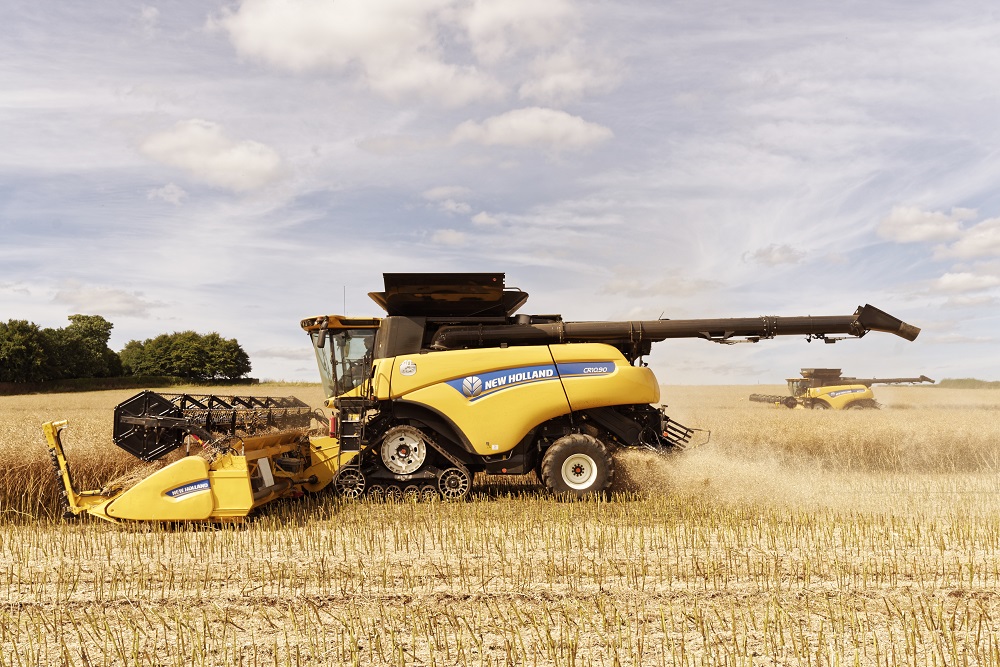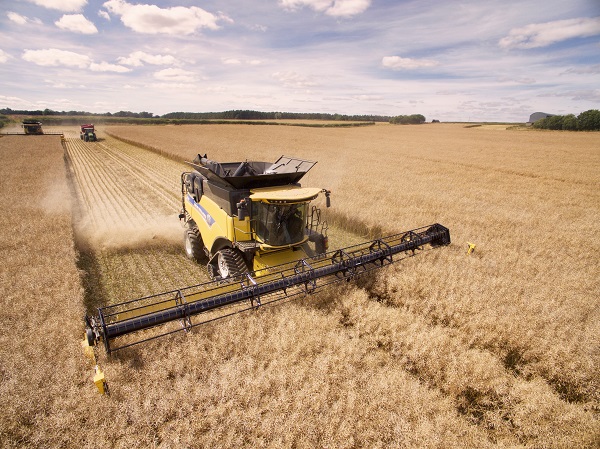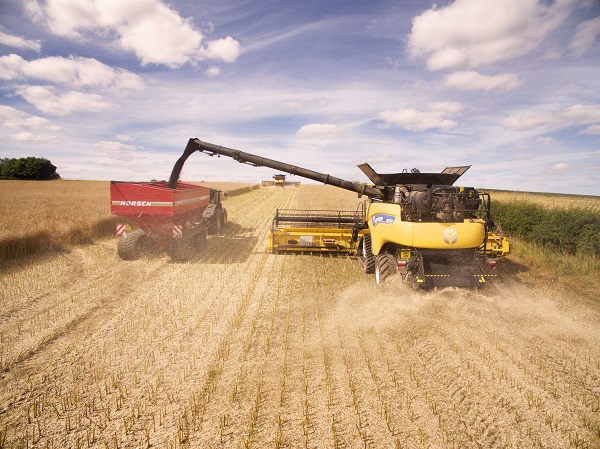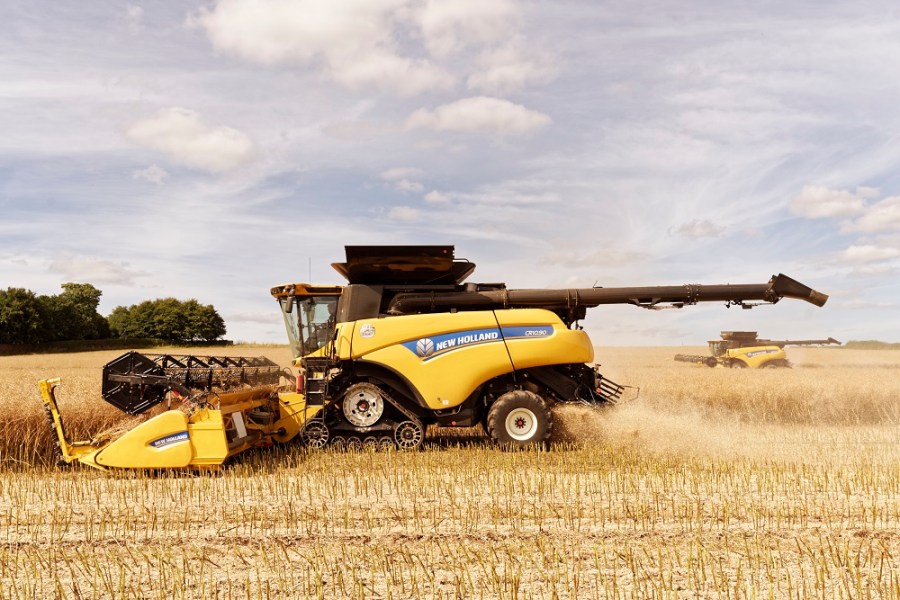
With 2000ha of combinable crops to cover in Scotland’s short growing season Berwicks based Mountfair Farming’s move to a controlled traffic system of farming was the catalyst that led to the purchase of a pair of New Holland CR10.90 combines in 2016. CPM reports.
The combines were really part of the evolution of the business as they allowed us to go to controlled traffic.
By Jane Brooks
Jorin and Aidan Grimsdale’s farming enterprise covers 2100ha of arable land, some on contract farming arrangements, together with their own farms Mountfair and Hilton, near Duns in the Scottish Borders.
Current cropping is 1250ha wheat with break crops 450ha oilseed rape, 200ha spring oats, 120ha vining peas and 80ha beans. Wheat varieties are Grafton, Revelation, KWS Lili, KWS Siskin, as well as Cordiale and Skyfall, with a small amount of Dickens and Silverstone in a variety comparison trial field.

The flagship of the New Holland range, the pair of CR10.90 combines arrived at Mountfair Farms in June 2016.
The OSR area’s split with 200ha Anastasia and DK Exalte, while a further 250ha of Eraton – a high erucic acid variety – is grown on different farms, so there’s no chance of contamination with non-HEAR varieties.
Mountfair Farm has the main grain storage, using a continuous flow drier and a biomass boiler with drying floors. There are another five drying systems on other contract farms all managed by Mountfair. Generally storage is all utilised within the farming business and they handle about 15,000t of crop. The wheat is stored and moved in the spring, with other crops harvested and generally sold for movement through Aug, Sept and Oct.
Agronomy decisions are based on NIAG TAB guidelines, supported by David Cairns of McCreath, Simpson and Prentice.
“We variably apply granular P & K, we don’t use fertiliser placement with wheat, but place phosphate and nitrogen with the OSR. Beans, which are generally grown for human consumption, are direct drilled with the CO12 Horsch or behind the leg of the Simba SL.

The Horsch Titan chaser bin completed its first season last year and its tracks have been found to spread the weight exceptionally well.
“Winter beans harvest nearly a week quicker than spring beans which is a benefit for us getting the following wheat in, but the winter beans don’t make human consumption grade as easily so they’re worth less.
“Vining peas for Scottish Border Produce provide an excellent break for wheat with often the best yields following the vining pea crop.
“We’ve been importing farmyard and hen manure for a number of years, swapping straw for muck with a local large beef farmer. A contractor spreads it for us, which is maintaining and increasing organic fertility,” explains Jorin Grimsdale.
The Grimsdales were early adopters of precision farming techniques including satellite technology for nutrient and yield mapping, variable rate seeding and fertiliser spreading and now use a 12m controlled track system.
“We’ve used GPS steering since 2002 – I think our John Deere 9420T was one of the first sold with the Starfire steering system in the UK. Currently we use John Deere Starfire mobile RTK correction supplied via Thomas Sheriff for the tractors and New Holland Mobile RTK via Lloyd Limited for the Combines.
“We also have a Yara N-sensor for variably applied nitrogen applications, which we like a lot – it’s excellent on OSR in absolute mode. The N Sensor works in real time, so in unsettled weather with short application windows there are no delays, which sometimes happens with satellite imagery,” he notes.
This year with low rainfall in April, fertiliser applications were applied faster through the wheat, as the farm uses urea. Crucial rain in May has given all crops a lift especially the spring oats, peas, and beans, reports Jorin Grimsdale..
“Autumn conditions were good for pre-emergence sprays and they’ve worked well. Our spring cropping was planted at the end of March and beginning of April when there was still plenty of moisture. We have sterile brome and are using some spring break crops to help keep on top of it. We don’t have the pressure of blackgrass yet, like further south, although it’s been found in OSR seed, which is often why we home save.”
Around 5% of the cropped area is ploughed, for vining peas and grassweed management, although generally he favours non-inversion. “The OSR is sown with a Simba SL700 cultivator, modified to apply fertiliser and with disc openers for placing the seed. Aidan is a keen fabricator and with a well equipped workshop and machinery base at Hilton, it’s allowed him to modify the machine to suit our requirements.”
Cultivations are handled by a 6m Simba SL700 and a 12m Kockerling Allrounder which can be used as a first pass cultivation tool in a CTF format. “With less wheelings and compaction it can go after the SL before drilling. It’s spring tined and excels working in front of the drill in the spring. It also has paddles, so for small areas of ploughing it levels and provides an excellent seedbed.”
Much of the wheat’s harvested in late Aug or early Sept – somewhat earlier than in England. OSR is normally desiccated in mid July then harvested during the first half of Aug. “A real concern for us in the North is the prospect of a glyphosate ban or label restrictions that will impact on pre-harvest applications, which will only make harvests later,” notes Jorin Grimsdale.
“There’s a small time window through Aug and Sept to desiccate, harvest, cultivate then drill, we try to get things to chit then spray if there’s time. Losing glyphosate would reduce the working window for harvesting and establishing crops. Everything needs finishing during the early half of Oct as it can get wet and cold by the end of the month.”
The Grimsdales use new equipment alongside older machinery generally buying new and running it for longer, the Horsch CO12 drill is 12 years old. They operate four John Deere tractors and hire in extra power at peak times.
“Last year just before the Brexit vote, my brother and I were looking into chaser bins and found a two year old tracked Horsch Titan for sale in Europe. With the exchange rate in our favour we decided to buy it, completing its first season with us last year. We thought we’d end up putting wheels on but the tracks have been impressive and spread the weight exceptionally well. We liked the simple design, build quality and it’s proved very reliable.”
In the same year, the combines were replaced, with a pair of New Holland CR10.90 combines arriving in June 2016. The flagship of the range, they’re powered by the Fiat Powertrain Technologies (FPT) Industrial Cursor 16. A 16-litre Tier 4B compliant, six-cylinder in-line ECOBlue HI-eSCR technology engine, it has a rated maximum power output of 652hp.
“We replaced two New Holland CR9090 combines, one was three years old, the other four years old. They were a stopgap as we were aware of the CR10.90 development when we bought them. This also coincided with the 12.5m VariFeed headers, which were required for the 12m CTF system as well as the longer folding unloading auger and pivoting spout, which is a great feature.
“The feed roller has allowed a traditional stone trap to be introduced which is better than the outgoing sensored bomb door which would stop the front elevator and combine to empty the object. This new system has improved performance,” adds Jorin Grimsdale.
The Twin Rotor threshing system has a speed regulated feed roll positioned at the top of the elevator, which helps create an even feed to the twin rotors and also operates as a continuous stone trap. New Holland claims the system results in better straw quality, cleaner grain sample and increases output by up to 15%.
The grain tank capacity is 14,500 litres and can achieve an emptying rate of over 140 litres/sec it also has in-cab operated hydraulic tank covers. They have SmartTrax rubber tracks with Terraglide suspension. There’s an extra-long folding 10m unloading auger and a 1300-litre fuel tank.
Jorin Grimsdale’s particularly impressed with the Terraglide suspended tracks. “They’re smooth on the road and in the field. The durability of it being properly suspended means there’s less jarring on the combine, which benefits the user. Its cab is quiet and comfortable. We’ve found the CR cab quieter than other makes whenever they’ve come in on demonstration.
“The biggest difference on these new CR’s is the driving style. A proportional method rather than your standard hydrostatic gait, it’s a different way of driving. You push the CommandGrip handle forward and it accelerates continuing to do so as long as you push the handle. When it reaches the speed you want, release the handle and it returns to the neutral position but maintains the forward speed. To slow down you pull it backwards to the speed you want or continue pulling back to stop.”
You can shuttle between forward and reverse by pushing a button on the back of the handle and then moving it forwards and backwards, he points out. “A lot of machines are going this way, with Vario transmission gearboxes having this type of methodology. You can tailor it to the driving style of the operator by selecting how fast it reacts but it takes a little getting used to.”
The combines can be equipped with two monitors – a 26.4cm IntelliView touchscreen and a second IntelliView display. Controls are sited on the right of the operator the key component is the CommandGrip multifunction handle, with its array of buttons providing control for most key procedures. The two screens allow operators to split information, for example, so all guidance, steering and mapping can be displayed on the pillar screen and main combine information displayed on the armrest.
“We’re very pleased with the CR10.90s because we’re getting the output required and managing harvesting traffic. There was an issue with the OptiSpread chopping and spreading system in that an oil pipe came off in the early weeks of operating. Both combines had pipes that failed but New Holland changed them, so hopefully this should be sorted now.
“Chopping and spreading 12m is a challenge but a few more adjustments have made big improvements. We had a couple of sensors cause issues, one on the header and one on the sieves. It was all fairly straightforward to remedy.
“On any new machine we’ve always found you get one or two little issues, which settle down once you’ve got the first couple of weeks out of the way.”
But there have been no big repair issues with New Holland CR combines over the years and Jorin Grimsdale notes running costs have been very good. “Like all machines they do break down which is why dealer back up and support is crucial.
“Our local dealer Lloyd Limited at Kelso does a fantastic job. We’ve operated New Holland CRs since 2002 when they were originally launched into the UK. We know and understand them very well, which has helped keep costs under control.
“Over the years we’ve compared combine operational costs with other farming businesses and are always pleasantly surprised how good the New Holland CRs have been for us. We often speak to friends up and down the country and compare running costs.
“On average when compared to most of the ranges in the biggest combine sector our old pair of combines ran for the price of one. The last two machines averaged £3.50/ha on wearing parts, breakages and winter service.
“These larger machines will cost slightly more but we think we should manage to keep it under £4.50/ha. We’re planning to run both CR10.90s for seven years, so in the later years we’ll see if build quality and reliability allow us to maintain similar running costs.”
The new 16-litre engine has better torque and power, with the CR10.90s achieving slightly better fuel usage than the outgoing CR9090s, although adblue litres/ha have increased.
“The best part of controlled traffic is harvest management. If we get a repeat of 2008 or 2012 where we had over 1000mm of rain in the year, with Aug and Sept getting 200mm plus, the controlled 12m spacing means the chaser bin can stay on the tramlines all the time, or if necessary follow the combines’ previous tracks.
“Hopefully it’ll help reduce damage to the fields and allow soils to improve, although just for harvest management everything’s simpler in the field because everyone knows where they should be.
“I fly a DJI Inspire drone for scouting the land. With that you notice the difference between non CTF and CTF trafficking systems, particularly where the combine turns, short runs, then the tractors and trailers turn, it’s not like that on the controlled traffic system”
Poised to gather Real Results
Jorin Grimsdale is one of 50 UK growers selected to participate in this year’s BASF Real Results Circle wheat fungicide trials, which will be conducted on their own farms under local conditions using their own machinery.
Over the coming months participants will test BASF SDHI fungicides against their choice of fungicide; on their farm, in their soil and in a way that conforms to their farm’s management systems, in order to prove conclusively which is the best wheat fungicide at T1 and T2.
The trials are conducted in partnership with BASF’s independent industry partners ADAS and precision mapping experts AgSpace who’ll assess each farm, map the trial areas, monitor crops, determine disease pressure and assess fungicide performance throughout the season. While ADAS will produce a detailed end-of-season report on the crop, outlining the results.
Over three years ADAS, funded by Innovate UK, has led the Agronōmics project developing, with the Courtyard Partnership, BASF, Trials Equipment, VSN International and the British Geological Survey, the statistics and software to help run on-farm trials.
ADAS and AgSpace are using Agronōmics new digital techniques for farm-based research, to provide the BASF Real Results Circle trials with scientific support to help growers design better trials as well as providing proper data analysis. Ensuring growers have more confidence in the results than they would ever have had before.
ADAS say Agronōmics is the science of field-scale cropping: it studies and compares spatially-defined cropped areas by gathering, analysing and interpreting multiple spatially-defined data, often with farmers using ‘precision farming’ technologies.
Adas say using Agronōmics to design the BASF Real Results Circle trials will help remove variance, pointing out that it’s crucial to ensure the comparisons fair to start with and that the two areas of the field chosen are comparable. They know there’s spatial variation in fields and it’s easy to come up with the wrong conclusion.
All 50 participants will also be invited to an end-of-year conference to share their trial results.
Farm Facts
Mountfair Farming, Duns, Berwicks, Scotland
- Farmed area: 2100 ha
- Cropping: Winter wheat, oilseed rape, beans, spring oats, vining peas
- Agronomist: NIAG TAB, supported by David Cairns of McCreath, Simpson and Prentice
- Soils: Heavy clay loam
- Mainline tractors: John Deere 9470RX (2016); JD 9420T (2002); JD 7930 (2011); JD 6155R
- Telehandler: JCB 550-80; JCB 536-60
- Precision: Yara N Sensor; John Deere Starfire mobile RTK via the Sheriff Group for tractors; New Holland Mobile RTK via Lloyd Limited for combines
- Combines: 2x New Holland CR10.90
- Chaser bin: Horsch Titan on tracks
- Drill: Horsch CO12
- Cultivator: Simba SL700 6m
- Plough: Kverneland
- Sprayer: Horsch Leeb PT280 36m
- Spreader: Amazone ZG-TS 8200 with Argus Twin
- Staff: Jorin and Aidan Grimsdale plus three full time staff and seasonal staff as needed
- Website: www.mountfair.co.uk




